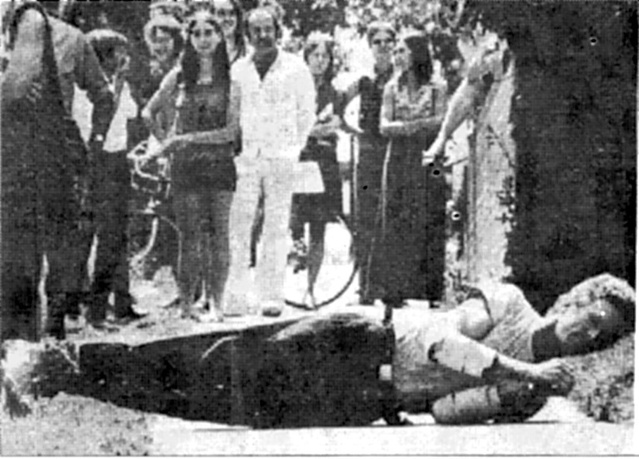Dreamsound: Event for Sleeping Audience (Richard Hayman)(Edit)
[from SAET : https://jeromejoy.org/SAET/index.php?page=1977dreamsound]
Related article / article connexe : ALAP (2013)
Description :(Edit)
3 jun 1973, Vehicule Art, Montreal (CA)
| Dreamsound, Event for Sleeping Audience (R.I.P. Hayman) (Dreamsound : Concert pour un public endormi de Richard Hayman) |
Overnight concert to accompany sleep. People were invited to come to Véhicule for the night and to sleep there.
Also presented at the Kitchen in New York, the Kitchen; the Western Front in Vancouver; and A Space in Toronto.
Dreamsound is a subliminal event for sleeping audience which encourages relaxation, comfortable sleep, and pleasant dreams. A variety of audio and visual media provide impetus to dream images. The event has been performed in many venues including the New Music America Festival and as an overnight radio concert.
Richard Hayman :(Edit)
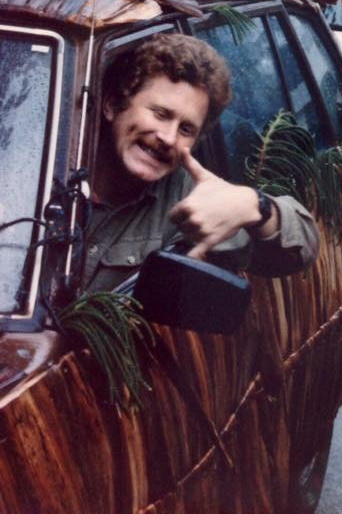 RIP Hayman ca. 1983 [Source] | Richard (R.I.P.) Hayman is an American composer and performer born in 1951 in New Mexico. He studied at Columbia University and with John Cage, Ravi Shankar, Chou Wen-chung, Petr Kotik, and Philip Corner. He has wandered the ways of newspaper boy, gardener, minstrel, medical aide, social worker, political campaigner, construction worker, pipe organ renovator, census enumerator, audio engineer, law researcher, sleep researcher, peddler (ear plugs in the subways), cook, bartender and publican, (Ear Inn), editor (Ear Magazine), and sailor (Eark). Hayman composes and performs music with voice, instruments, electronics and effects for concert, theater, dance, media events, film and video [other version : As a composer, he has worked with voice, flute, piano, organ, ensembles, orchestra, ocarinas, tape, electronics, bells, percussion, telephones, toys, words, dance, theater, kites, horses, sleep, the blind, dry ice, film, video, fire, and visual phenomena.] He was a founding editor of the NY edition of Ear magazine, 1975-1991, and he's presently Director of the Board of Trustees of the Sari Dienes Foundation — the painter Sari Dienes performs with Rip Hayman, Charlie Morrow and Barbara Pollitt on recording of Hayman’s ‘Sleep Song’ on Dreamsound. RIP, she [Sari Dienes] and now-famous sociologist of retail Paco Underhill—then Chairman of the New Wilderness Foundation—bought the 18th-century building, with a longshoreman’s bar, at 326 Spring Street NYC. He also had to run the bar in 1977. He simply blanked out part of the first letter in the generic neon BAR sign to rename it the EAR, and it is now known as the Ear Inn. The EAR Inn, a gathering place for artists and locals, was born. The bar has featured music and poetry events with performers like Mike Bloomfield, Laurie Anderson, Allen Ginsberg and John Ashbery. RIP Hayman met the music composer Charlie Morrow, in Philip Corner’s project, “Sounds Out of Silent Spaces.” Hayman and Morrow worked together organizing public events, the Ocarina Orchestra (ocarina players including RIP Hayman, Mary Nell Hawk and Charlie Doria, etc.), the Great Wind Band and, most importantly, EAR Magazine, which Hayman took over from Beth Anderson. — [EAR magazine archives] Hayman, who is a licensed merchant marine captain, has also been pursuing other projects, including organizing cruises on the Yangtze River in China, trying to start a Hudson-to-Albany riverboat line and composing projects Dreamsounds: Music for Sleeping People., and On the Way..., Music for the Near-Death Experience, cd released by Deep Listening in 1995. A noted sinologist, he curated Tellus #19 New Music China, 1988. In the mid-1980s, Hayman was exploring the musical dimension of sleep and dream. He organised Dreamsound events for sleeping audiences, what he calls ‘social-musical slumber parties’ (MusicWorks#38, p24). To put audiences to sleep, he had a secret weapon: ‘I play Bach’s Goldberg Variations which was commissioned by Count Keyserling to put himself to sleep’ (from interview, tr.#14), though, to be honest, he also served camomille tea and warm milk (MusicWorksW#38, p25). |
| "My interest in music and performance is the exploration of acoustic social phenomena. The work is based in the awareness of sound, mingling meditation, mystery, humor, and human response. It is tangible spirit intended for live audience/participants. I seek the unheard... for people, who are the source of my life. It is done with love: caring, continuance, and ecstasy. I do this because it is the most real and imagined, detached and involved, earthy and ethereal way I can live and never know what will be. Hearing is believing!" (Richard RIP Hayman) |
Other similar Dreamsound events :
- The Western Front, Vancouver, March 13, 1976
- Programme: Takes from Dreamsound, Breath Tape, Dream Walking – Guy Lombardo, Sleepwhistle, Ghost Cartoon; Temier tribe dream chants (Malaysia) ; Participants Suggestions to themselves in Sleep Spirits – for piano ; Audio Recording duration: 26:34
- Source : http://front.nfshost.com/newmusic/events/1985 , http://front.bc.ca/events/dreamsound/
- Houston, April, 1986
- april 6–7 — R.I.P. Hayman : Dreamsounds: An overnight sleepover performance; Holiday Inn ; New Music Alliance.
- Source : http://en.wikipedia.org/wiki/List_of_New_Music_America_performances
- Harvestworks Residencies, 1986
- An “event for a sleeping audience” based on the artist’s research in sound recognition in dream sleep. The premiere performance is at New Music America, April 1986.
- Source : http://www.harvestworks.org/1986-new-works-residency/
- 1987
- Sari Dienes performs with Rip Hayman, Charlie Morrow and Barbara Pollitt on recording of Hayman’s Sleep Song on Dreamsound.
- Source : http://saridienes.org/life/1980-1992.html
- New York City’s Penine Hart Gallery, 1988
- The two-dozen concertgoers spread out their sleeping bags on the ground and settled in for a long night. It was a cold January evening in 1988, but the setting was soothing inside New York City’s Penine Hart Gallery, with incense and lavender wafting through the air. A fireplace crackled on a video monitor, and Bach's Goldberg Variations played quietly. Soon, milk and cookies were passed around, and an artist named R.I.P. Hayman and his assistant, Barbara Pollitt, commenced their performance in earnest.
As the attendees tucked themselves in, Hayman and Pollitt played minimalist patterns on flute and harp. The room gradually filled with a soft chorus of deep breathing, and eventually a barely-audible tape of what the Village Voice critic Kyle Gann described as "beautiful, wave-patterned organ music." After that, it's hard to know exactly how the performance went, because Gann fell asleep along with the rest of the room, save for Hayman and Pollitt. The musicians were hardly offended, though: This was one of Hayman's Dreamsoundevents, and falling asleep was the point.
"Nobody dreams in silence," Hayman, 65, tells me from his home in New York's Hudson Valley. His aforementioned Dreamsound performances were neither merely musical nor social affairs, but extensions of the artist’s longstanding interest in capturing the actual sound of dreams.
His quest stretches back to the ’70s, when he spent a year volunteering as a research subject in studies analyzing MEMA (middle ear muscle activity), a phenomenon roughly analogous to the REM (rapid eye movement) states that accompany intense dream activity. In MEMA, which often anticipates and accompanies REM sleep, the tympanic tensor muscles of the eardrum twitch as if in response to actual acoustic input. Hayman, who has always had what he calls a "vivid dream imagination," was in his 20s then, and his stint as a sleeping guinea pig led him to a striking thought: What if the auditory landscape of dreams could be reverse-engineered by tracking the movements of the middle ear muscles?
Hayman's goal was to eavesdrop on dreams—as though Francis Ford Coppola's The Conversation were to meet Christopher Nolan's Inception.
The idea makes a certain, if audacious, kind of sense. The eye-swivels of REM don't tell us anything about what the brain thinks it sees; they go only up, down, and side to side, like a robotic appendage—directional but senseless. But the vibrations of the inner ear, theoretically, could be an entirely different matter: If the nerve endings were found to fire in response to specific, dreamed sounds—the bark of a dog, say, or the tolling of church bells—then each of those sounds could leave a fingerprint in the form of frequency, wavelength, and amplitude.
To test his theory, Hayman took his custom-fit sensors—pressure-strain gauges that were inserted into the inner ear, which created encephalograph readings of MEMA phenomena—and outfitted them with microscopic microphones. The goal was to eavesdrop on the dream, essentially—as though Francis Ford Coppola's The Conversation were to meet Christopher Nolan's Inception.
"The techniques were just too crude," Hayman says of his early experiments. "The sound of breathing or blood flowing nearby overwhelmed any reading we got." Though neurologists have told him his theory of recording the sound of dreams is “impossible,” he’s still holding out hope: “I'm waiting for someone to say, 'Now we can do it.'" Considering recent breakthroughs in reconstructing audio from visual information—like the researchers at MIT who managed to decipher a conversation frombehind soundproof glass by watching a video of a bag of potato chips that sat in the same room as the speakers—perhaps that day isn't far away.
In any case, Hayman, whose biography reads like something out of a Pynchon novel—a former student of John Cage, pipe-organ restorer, licensed sea captain, maritime historian, publisher, and sinologist who once composed a multimedia installation based on his own near-death experience—is no stranger to quixotic undertakings. (One of his early compositions, Bell Roll, involves donning a suit covered with bells and rolling down a hill.) A dedicated preservationist, he is the co-proprietor of a 200-year-old landmark building in Manhattan that currently houses the Ear Inn tavern as well as a WWII yawl that Hayman rescued from the bottom of the Connecticut River. His attraction to projects that seem impossible amounts to "a story of perseverance," he says, laughing. "Folly and perseverance."
Not long after taking part in those MEMA experiments and writing his own paper, Listening to Dreams: A Project for Middle Ear Muscle Activity Audio Level Telemetry, Hayman staged his first Dreamsound concert in 1975 at the University of California, Berkeley, and he was soon bringing the concept to galleries and private homes across the country. Over time, he developed a format that encompassed a wide range of practices: chamomile tea, lavender oils, and Bach's Goldberg Variations, which are said to have been composed at the behest of an insomniac count who craved a soundtrack for his sleepless nights. The events were not limited to the merely aesthetic or sensory, either: Attendees were given paper and pens, should they wish to write down the night's visions. Hayman would even come around with a tape recorder, so that each participant could speak a short phrase to be played back to them while they slumbered—the better, went the theory, to help guide their dreaming.
Medical research, neurological theories, and what Hayman calls "the spiritual aspects of the long tradition of dream oracles and long-night events" all came together in one potent mix. Still, despite the faintly New Age airs, Hayman's sleep-based art was also imbued with a generous sense of humor—hence his "Snore Sonata", from 1987's Dreamsound cassette, featuring a multi-tracked chorus of snoring, and his Fluxus-like performance piece "Sleep Whistle", in which the performer naps in public with a whistle stuck in his or her mouth.
Whereas Hayman introduced the idea of the sleep concert as a fusion of ritual and avant-garde performance, it would fall to the California ambient musician Robert Rich to popularize the format. When Hayman pulled off his first all-nighter in Berkeley in 1975, Rich was just 12 years old and living just 39 miles away, in Menlo Park.
Like Hayman, Rich was interested in the convergence of avant-garde aesthetics with traditional rituals from around the world, like the gamelan orchestras of Indonesia and the Blessing Way ceremonies of the Navajo. American culture, he felt, sorely lacked these kinds of community rituals—save, perhaps, for rock concerts. But, as an introvert, he sought out a mode of expression that was the exact opposite of rock'n'roll's emphasis on spectacle. "I wanted to create a sense of meditative depth by shifting expectations away from entertainment and into deep listening," he says.
Rich held his first sleep concert in 1982, in his freshman year at Stanford University—a school he had chosen, in part, for the acclaimed sleep-research unit of its psychiatry department. After he tacked up some flyers around campus—“bring a sleeping bag,” they advised—around 20 people spread out on the blue shag rug of his dorm’s common room, where he had set up his modular synthesizer, a pair of cassette players, and a handful of effects.
Rich continued to develop his shamanistic style at sleep concerts throughout the decade, creating complex, perpetually evolving soundscapes designed to trigger, and guide, the imagination. He likens the process to a moving river: "You're going to see things like little insects and leaves and reflections of the sky floating on the surface, but underneath that, there's a slow-moving current that's always changing; it's never going to be the same river twice."
— (a review by Philip Sherburne) - Source : http://pitchfork.com/features/article/9738-songs-in-the-key-of-zzz-the-history-of-sleep-music/

Robert Rich playing a sleep concert at the Copenhagen Contemporary Art Center, 2015 - Photo by Yann H. Andersen.
- The two-dozen concertgoers spread out their sleeping bags on the ground and settled in for a long night. It was a cold January evening in 1988, but the setting was soothing inside New York City’s Penine Hart Gallery, with incense and lavender wafting through the air. A fireplace crackled on a video monitor, and Bach's Goldberg Variations played quietly. Soon, milk and cookies were passed around, and an artist named R.I.P. Hayman and his assistant, Barbara Pollitt, commenced their performance in earnest.
- 1st Annual Dream Festival — Ione's Dream Festival - A Celebration of Dreams, Kingston NY — 26 October 1996
- A Dream Festival in Kingston will celebrate dreams and dreamers from Kingston and surrounding areas of the Hudson Valley. The Festival will begin on Saturday, October 26 with DREAMSOUND, EVENT FOR SLEEPING AUDIENCE, by noted composer R.I.P. HAYMAN. Reservations are necessary. This event is limited to 40 dreamers. The event will be a benefit for the Pauline Oliveros Foundation is the first event to take place in the organization's new building DEEPLISTENING SPACE at 73 Broadway in the Rondout.
"This is purely a celebration of dreams, something we all share, even those of us who don't remember them," says Ione, the author, director and psychotherapist who is also co-artistic director of the Pauline Oliveros Foundation. "Dreams are funny, strange, sometimes scary but always interesting aspects of our lives. I think if we all paid more attention to them we'd learn more about ourselves and each other. Essentially we'll be creating what is called Dream Community in Kingston." - Source : http://www.nyfa.org/current_archive/1996/cur090996.html
- Source : http://deeplistening.org/site/content/dream-fest-history
- A Dream Festival in Kingston will celebrate dreams and dreamers from Kingston and surrounding areas of the Hudson Valley. The Festival will begin on Saturday, October 26 with DREAMSOUND, EVENT FOR SLEEPING AUDIENCE, by noted composer R.I.P. HAYMAN. Reservations are necessary. This event is limited to 40 dreamers. The event will be a benefit for the Pauline Oliveros Foundation is the first event to take place in the organization's new building DEEPLISTENING SPACE at 73 Broadway in the Rondout.
- 5th Annual Dream Festival – October 2000
- Overnight Concert: Dreamsound – Concert for sleeping Audience by Composer RIP Hayman.
- Source : http://deeplistening.org/site/content/dream-fest-history
Releases :
- R.I.P. Hayman – Dream Sound : India Transformed — Cassette — New York, N.Y. : New Wilderness Foundation, 1980
- R.I.P Hayman - Excerpts from Dreamsound, an event for a sleeping audience (29:09)
- R.I.P Hayman - Dreamsound - India Transformed (29:20)
- Collection New Wilderness Audiographics — N°8115A
- Source : http://www.newwilderness.org/cassettes.html
- Source : http://www.worldcat.org/search?q=se%3A%22New+Wilderness+audiographics%22&fq=&dblist=638&qt=sort&se=yr&sd=asc&qt=sort_yr_asc
- Source : https://audiographics.bandcamp.com/album/7914a-dreamsound-india-transformed
Produced by Denis Thalson and Charlie Morrow
Performed by R.I.P. Hayman
released April 21, 1980
- R.I.P. Hayman – Hearsayseeing — Cassette — New York, N.Y. : New Wilderness Foundation, ?
- Collection New Wilderness Audiographics — N°8115B
- Source : http://www.newwilderness.org/cassettes.html
- Source : http://www.charliemorrow.com/audiographics.html
- R.I.P. Hayman – Dreamsound — Cassette, C66 (released 1987) — © R.I.P. Hayman / Other Media (ASCAP) 1987 :
- Sleep Song — Performer [With] – Barbara Pollitt, Charlie Morrow, R.I.P.Hayman, Sari Dienes Producer — [Produced With] – Emily Evans, Mark Sloan — Sleep Song produced at Artist Acces [sic] Studio, NYC
- Snore Sonata — Producer [Produced With] – Daniel Shklair — produced at Studio PASS NYC
- included also in Musicworks #38 audio cassette, Bridging Language (Cassette+journal released by Musicworks, Toronto, 1986) — Recorded By – R.I.P. Hayman, 1986. Hayman contributes sleeping sounds contingencies: a few volunteers were recorded yawning and snoring, and he re-arranged it in the form of quartets.
- Yawn Quartet — Performer [With] – Daniel Shklair, Kathy Coleman, Stephen Horlick, Vicki Stern — Producer [Produced With] – Daniel Shklair — produced at Studio PASS NYC
- included also in Musicworks #38 audio cassette, Bridging Language (Cassette+journal released by Musicworks, Toronto, 1986) — Recorded By – R.I.P. Hayman, 1986.
- in addition on Musicworks #38 audio cassette, Bridging Language : R.I.P. Hayman Discussing The Influence Of Yawning On The Listener, in conversation with Gordon Monahan, sound recording, April 1986.
- Dreamwaves — Producer [Produced With] – Daniel Shklair — produced at Studio PASS NYC
- Source : http://www.discogs.com/RIP-Hayman-Dreamsound/release/2452446
- Source : http://www.deeplistening.org/site/content/rip-hayman-dreamsound-0 (cassette, Deep Listening Institute)
- Source : http://www.deeplistening.org/site/content/dreamsound (cd, Deep Listening Institute)
Audio :(Edit)
R.I.P Hayman - Excerpts from Dreamsound, an event for a sleeping audience (29:09)
Source : https://audiographics.bandcamp.com/album/7914a-dreamsound-india-transformed
Produced by Denis Thalson and Charlie Morrow
Performed by R.I.P. Hayman
released April 21, 1980
R.I.P Hayman - Dreamsound, India Transformed (29:21)
Source : https://audiographics.bandcamp.com/album/7914a-dreamsound-india-transformed
Produced by Denis Thalson and Charlie Morrow
Performed by R.I.P. Hayman
released April 21, 1980
R.I.P Hayman - Nightsongs (1:26)
Source : http://www.ubu.com/sound/tellus_19.html
http://www.harvestworks.org/tellus-19-new-music-china/
Excerpt from score by R.I.P. Hayman for the award-winning film about immigrant life in Chinatown.
In audio cassette Tellus #19 New Music China (1988)
Documentation :(Edit)
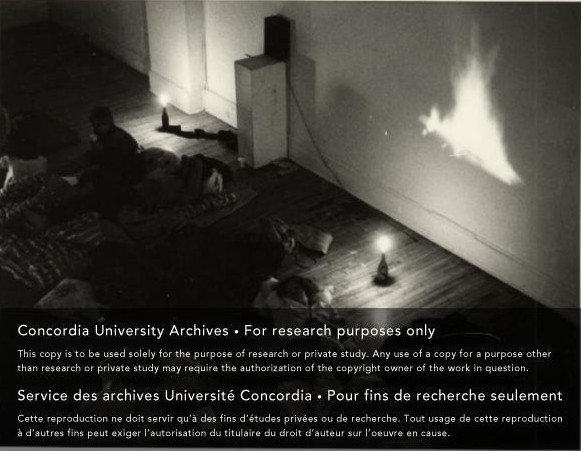 Dreamsound at Vehicule Art Gallery Fonds Véhicule Art (Montréal) Inc. Véhicule Art (Montréal) Inc. fonds Concordia University Archives |
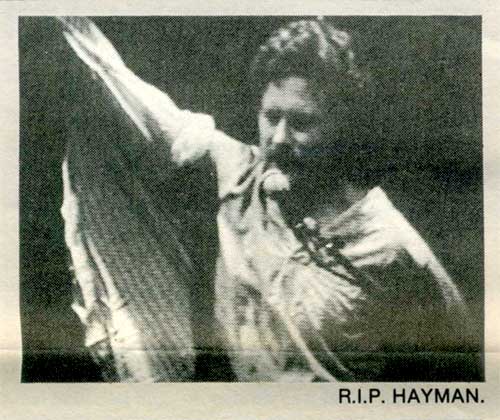 R.I.P. Hayman, Musicworks 38 (1986) — [Source] |
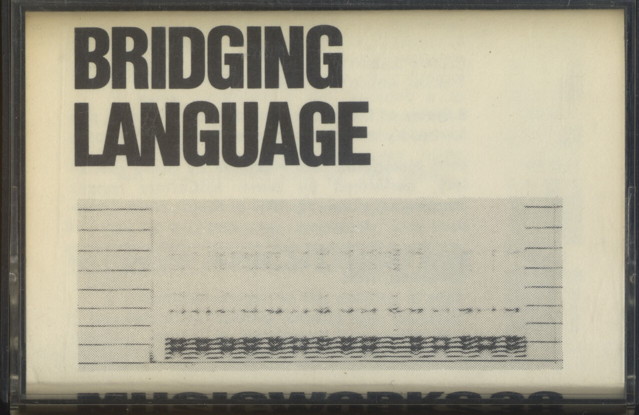 Musicworks 38, cassette, (1986) — [Source] |
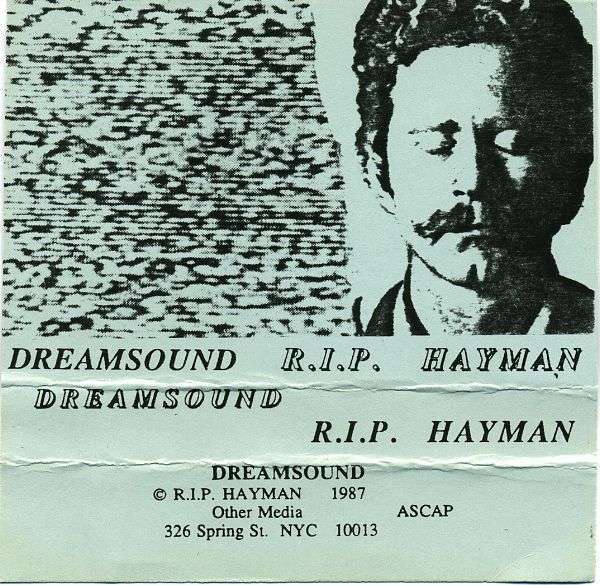 R.I.P. Hayman, Dreamsound, © R.I.P. Hayman / Other Media (ASCAP) 1987 — audio cassette - Caution: Lie down before listening. Quiet volume recommended. 1/ Sleep Song / Performers – Barbara Pollitt, Charlie Morrow, R.I.P.H., Sari Dienes 2/ Snore Sonata / Performer – R.I.P.H. 3/ Yawn Quartet / Performers – Daniel Shklair, Kathy Coleman, Stephen Horlick, Vicki Stern 4/ Dreamwaves / Engineer – Daniel Shklair / Performer – R.I.P.H. Sleep Song performed at Artist Access Studio, NYC all others performed at Studio PASS NYC. — [Source] — [Source] — [Source] |
Reviews :(Edit)
- GANN, Kyle. "Music Downtown: Writings from The Village Voice", University of California Press, 2006
R.I.P. Hayman, Dreamsound, pp. 222-224.
And (original article) : Yawn (R.I.P. Hayman) - February 16, 1988 (The Village Voice, Vol. XXXIII No. 7, p. 98)
See above : New York City’s Penine Hart Gallery, 1988
- IONE (LEWIS, Carole Ione). "Listening in Dreams: A Compendium of Sound Dreams, Meditations and Rituals for Deep Dreamers", Lincoln, LE : in Universe & This is a Dream (Pubs), 2000-2001
R.I.P. Hayman, Dreamsound, p. 31.
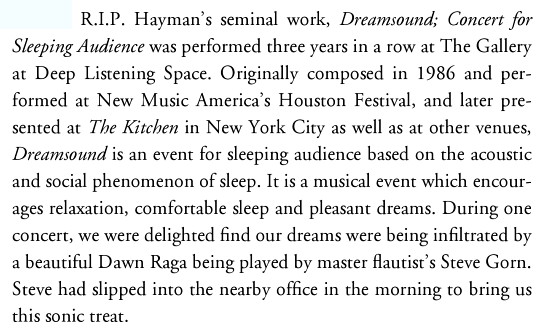 Ione, Listening in Dreams: A Compendium of Sound Dreams, Meditations and Rituals for Deep Dreamers, (2000-2001) |
Sources, Urls :(Edit)
- http://ccca.concordia.ca/resources/searches/event_detail.html?languagePref=en&vk=8982 — [Retrieved on 30 oct 2013]
- http://archives.concordia.ca/sites/default/files/uploaded-documents/pages/2011/01/06/chronology_0.pdf — [Retrieved on 30 oct 2013]
- http://archives.concordia.ca/P027_im_photos — [Retrieved on 1 nov 2013]
- http://www.nytimes.com/2001/12/30/realestate/streetscapes-326-spring-street-fixture-on-the-block-may-face-an-upstart-neighbor.html — [Retrieved on 1 nov 2013]
- http://archives.nypl.org/uploads/collection/pdf_finding_aid/musear.pdf (Ear magazine records, New York Public Library Archives & Manuscripts) — [Retrieved on 1 nov 2013]
- http://www.newwilderness.org/ear.html (Ear magazine) — [Retrieved on 1 nov 2013]
- https://www.youtube.com/watch?v=a-JGz6e7jKg (2011 Institute of Ecotechnics Mediterranean Conference, Aix-en-Provence, France 7-10 October) — [Retrieved on 1 nov 2013]
- http://deeplistening.org/site/content/rip-hayman — [Retrieved on 1 nov 2013]
On the Way (Richard Hayman)(Edit)
"On the Way . . . " is available from the composer Pauline Oliveros' Deep Listening label (P.O. Box 1956, 601 Broadway, Kingston, NY 12401-0900), it offers 54 minutes of bass-heavy ambience with sliding tones and gentle sound effects on top.
"I wanted to create a sense of infinity," said Hayman, a composer from Pomona, N.Y. "I liken it to when you walk in a vast space like a cathedral, where there's no music and no sound but you feel the resonance and have an altered state of hearing. When I showed this and played the music at a medical conference for people who had near-death experiences, many came up and said: `That's it! I've never heard that expressed before.' "
These sounds, as heard on Radigue's 1990 "Kyema" CD, are actually quite similar to Hayman's.
Hayman said his near-death experience occurred in 1989, when he was hospitalized with cardiac arrhythmia. The following year, he began working on an installation in which visitors lie down in a small room where his experience is replicated with a soft, glowing tunnel of light and enveloping sound from multiple speakers.
"Eventually, everyone will have that sensation, I hope, because it was a wonderful revelation," Hayman said. "There was a great sense of peace that I hope that these digital bits can give a small sense of."
(from Neil Strauss, http://www.deseretnews.com/article/493023/RIP-HAYMANS-ON-THE-WAY-—-CREATES-SENSE-OF-INFINITY.html )
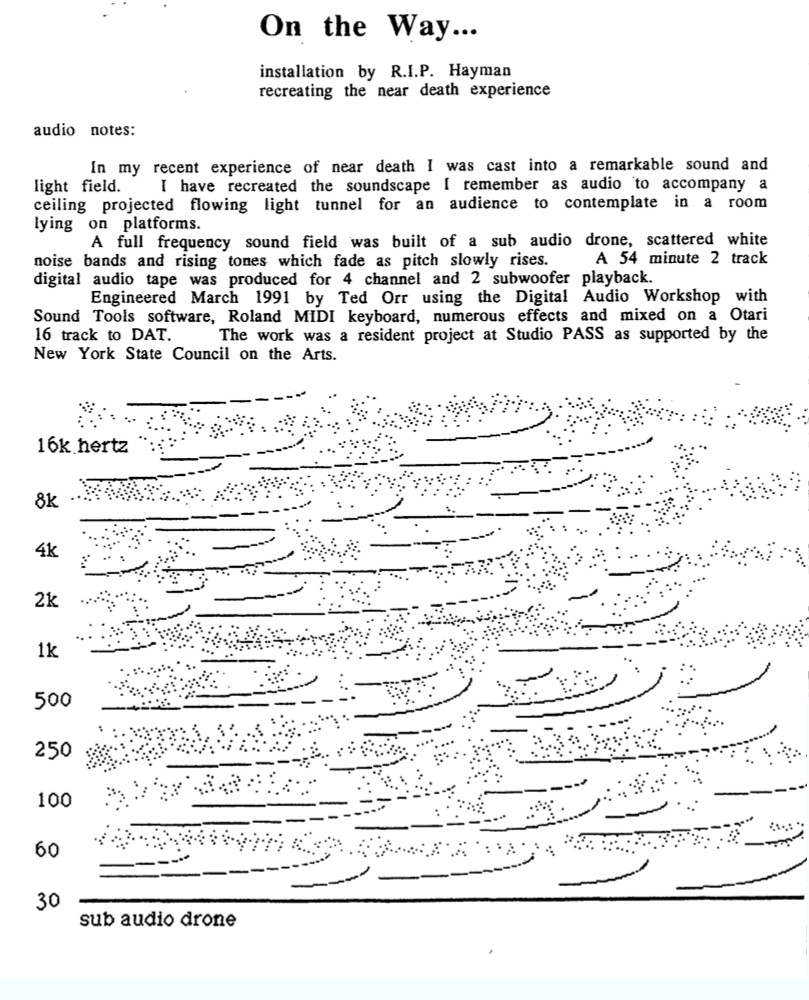
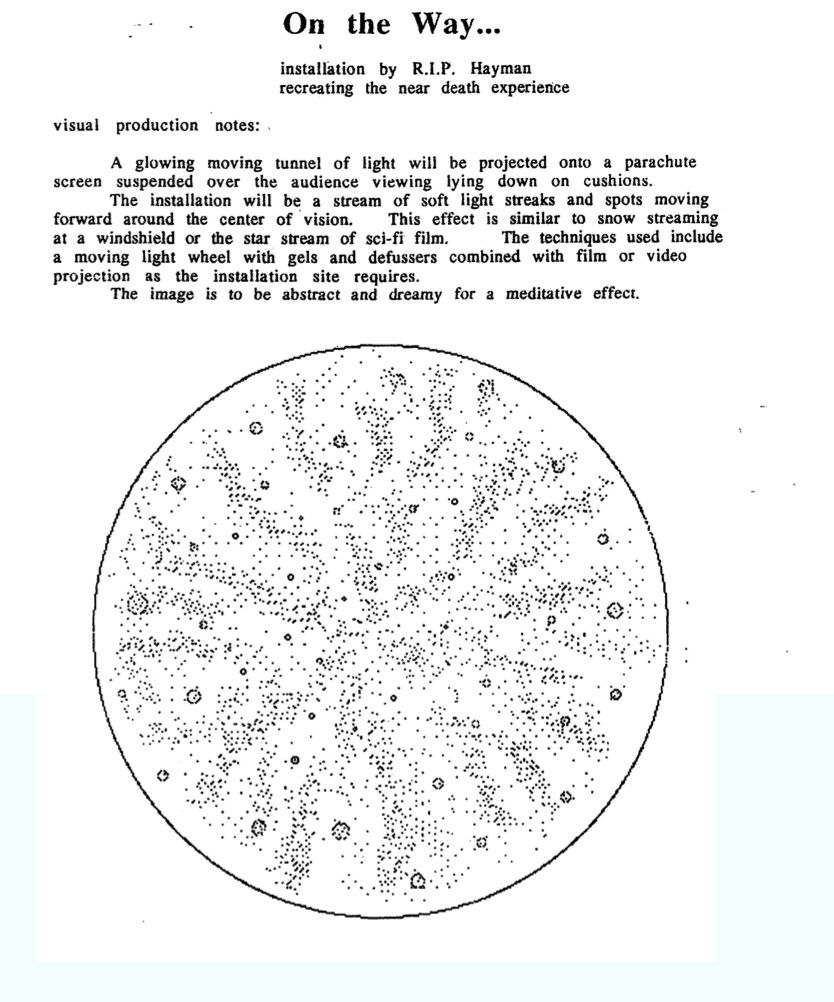
REFERENCES :
- http://www.lns.com/sc96/events/way.html
- http://www.sial.rmit.edu.au/Projects/File/On%20The%20Way.pdf
John Cage & Richard Hayman(Edit)
[John Cage] replies to the composer and editor R.I.P. Hayman, who had asked him, “Is politics to society what music is to sound?” The question, Cage remarks, is “a little too mathematical,” but he goes on to answer, “yes if music is thought of as a body of laws to protect musical sounds from noises, as government protects rich from poor.”
— (Alastair Macaulay, in a review of The Selected Letters of John Cage)
